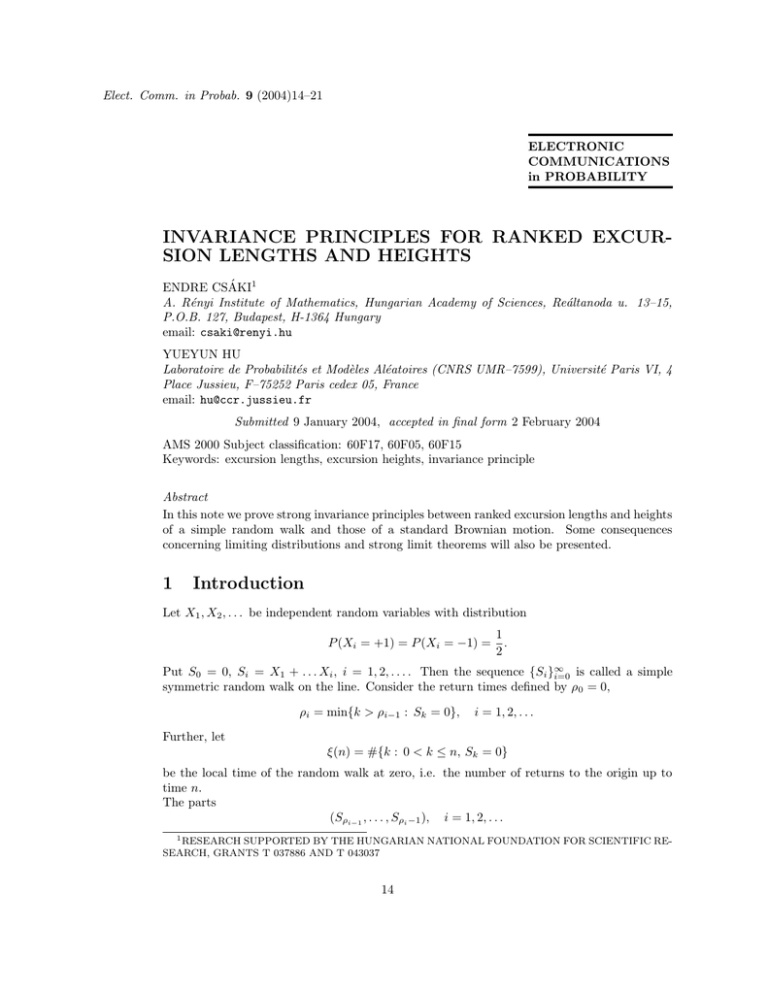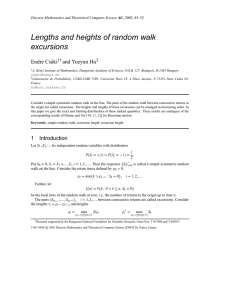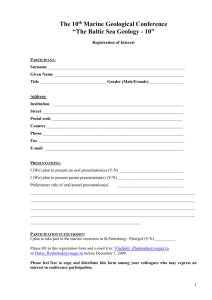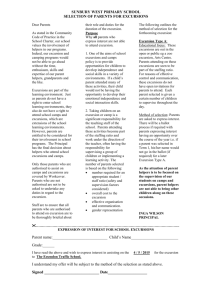INVARIANCE PRINCIPLES FOR RANKED EXCUR- SION LENGTHS AND HEIGHTS
advertisement

Elect. Comm. in Probab. 9 (2004)14–21
ELECTRONIC
COMMUNICATIONS
in PROBABILITY
INVARIANCE PRINCIPLES FOR RANKED EXCURSION LENGTHS AND HEIGHTS
ENDRE CSÁKI1
A. Rényi Institute of Mathematics, Hungarian Academy of Sciences, Reáltanoda u. 13–15,
P.O.B. 127, Budapest, H-1364 Hungary
email: csaki@renyi.hu
YUEYUN HU
Laboratoire de Probabilités et Modèles Aléatoires (CNRS UMR–7599), Université Paris VI, 4
Place Jussieu, F–75252 Paris cedex 05, France
email: hu@ccr.jussieu.fr
Submitted 9 January 2004, accepted in final form 2 February 2004
AMS 2000 Subject classification: 60F17, 60F05, 60F15
Keywords: excursion lengths, excursion heights, invariance principle
Abstract
In this note we prove strong invariance principles between ranked excursion lengths and heights
of a simple random walk and those of a standard Brownian motion. Some consequences
concerning limiting distributions and strong limit theorems will also be presented.
1
Introduction
Let X1 , X2 , . . . be independent random variables with distribution
P (Xi = +1) = P (Xi = −1) =
1
.
2
Put S0 = 0, Si = X1 + . . . Xi , i = 1, 2, . . . . Then the sequence {Si }∞
i=0 is called a simple
symmetric random walk on the line. Consider the return times defined by ρ 0 = 0,
ρi = min{k > ρi−1 : Sk = 0},
i = 1, 2, . . .
Further, let
ξ(n) = #{k : 0 < k ≤ n, Sk = 0}
be the local time of the random walk at zero, i.e. the number of returns to the origin up to
time n.
The parts
(Sρi−1 , . . . , Sρi −1 ), i = 1, 2, . . .
1 RESEARCH SUPPORTED BY THE HUNGARIAN NATIONAL FOUNDATION FOR SCIENTIFIC RESEARCH, GRANTS T 037886 AND T 043037
14
Excursion Lengths and Heights
15
between consecutive returns are called excursions. Consider the lengths
τi = ρi − ρi−1 ,
and heights
µi =
max
ρi−1 ≤k≤ρi −1
µ+
i =
max
|Sk |,
ρi−1 ≤k≤ρi −1
Sk
of i-th excursion.
Clearly, the random walk does not change sign within an excursion. We may call the excursion
positive (negative) if the random walk assumes positive (negative) values within this excursion.
If the i-th excursion is negative, then µ+
i = 0.
In this paper we consider the ranked lengths and heights of excursions up to time n. In general,
however the (fixed) time n need not be an excursion endpoint, and we include the length and
height of this last, possibly incomplete, excursion as well. Consider the sequences
L(1) (n) ≥ L(2) (n) ≥ . . . ,
M (1) (n) ≥ M (2) (n) ≥ . . . ,
and
(1)
(2)
M+ (n) ≥ M+ (n) ≥ . . . ,
where L(j) (n) is the j-th largest in the sequence
(τ1 , τ2 , . . . , τξ(n) , n − ρξ(n) ),
M (j) (n) is the j-th largest in the sequence
(µ1 , µ2 , . . . , µξ(n) ,
max
ρξ(n) ≤k≤n
|Sk |),
(j)
while M+ (n) is the j-th largest in the sequence
+
+
(µ+
1 , µ2 , . . . , µξ(n) ,
max
ρξ(n) ≤k≤n
Sk ).
(j)
We define M+ (n) = M (j) (n) = L(j) (n) = 0 if j > ξ(n) + 1.
Let {W (t), t ≥ 0} be a standard one-dimensional Brownian motion starting from 0. For t > 0
denote by
V (1) (t) ≥ V (2) (t) ≥ · · · ≥ V (n) (t) ≥ · · · > 0,
the ranked lengths of the countable excursions of W over [0, t]. We mention that this sequence
includes the length t − g(t) of the incomplete excursion (W (s), g(t) ≤ s ≤ t), where g(t) :=
sup{s ≤ t : W (s) = 0}.
Let furthermore
(1)
(2)
(n)
H+ (t) ≥ H+ (t) ≥ . . . H+ (t) ≥ · · · > 0
and
H (1) (t) ≥ H (2) (t) ≥ ...H (n) (t) ≥ ... > 0
16
Electronic Communications in Probability
denote the ranked heights of countable positive and all excursions, resp. of W over [0, t].
These sequences include the heights supg(t)≤s≤t W (s) and supg(t)≤s≤t |W (s)| of the incomplete
excursion (W (s), g(t) ≤ s ≤ t).
The properties of these quantities for Brownian motion were investigated by Wendel [15],
Knight [11], Pitman and Yor [13, 14] and their strong limit properties were studied in [8, 9],
[3, 4, 5]. In [2] the properties of L(1) were investigated. For random walk excursions exact and
limiting distributions were studied in [6].
In this paper we prove strong invariance principles for ranked lengths and heights and discuss
certain consequences for limit theorems.
2
Invariance principle
We shall approximate the heights and lengths of random walk excursion by those of Brownian
motion, using Skorokhod embedding.
Define σ(0) = 0 and
σ(n) = inf{t > σ(n − 1) : |W (t) − W (σ(n − 1))| = 1},
n ≥ 1.
Take Si := W (σ(i)). Then {Si }∞
i=0 is a simple random walk obtained by Skorokhod embedding
(j)
and we make use of the notations (ξ(n), M+ (n), M (j) (n), L(j) (n)) introduced in Section 1.
Theorem 2.1 Almost surely, we have
1
(j)
(j)
max |M (n) − H+ (n)|
(log n)1/2 (log log n)1/4 1≤j≤ξ(n) +
1
lim sup
max |M (j) (n) − H (j) (n)|
1/2
(log log n)1/4 1≤j≤ξ(n)
n→∞ (log n)
1
lim sup √
max |L(j) (n) − V (j) (n)|
n
log
log n 1≤j≤ξ(n)
n→∞
lim sup
n→∞
≤
3,
(2.1)
≤
3,
(2.2)
≤
6.
(2.3)
We state below some known results as facts:
Fact 2.2 Csörgő and Révész ([7], Theorem 1.2.1) Let at be a non-decreasing function
of t such that 0 < at ≤ t and t/at is non-decreasing. Then
lim sup p
t→∞
1
sup |W (u + s) − W (u)| = 1,
sup
2at (log(t/at ) + log log t) 0≤u≤t−at 0≤s≤at
a.s.
Fact 2.3 We have
µ
¶
∞
π2
4 X (−1)k
2
exp − (2k + 1) x , x ≥ 0,
P (σ(1) ≥ x) =
π
2k + 1
8
k=0
p
1
2
lim sup √
max |σ(j) − j| = 2 Var(σ(1)) = √ , a.s.,
n log log n 1≤j≤n
n→∞
3
1
8
lim
max (σ(j) − σ(j − 1)) = 2 , a.s.
n→∞ log n 1≤j≤n
π
(2.4)
(2.5)
(2.6)
Excursion Lengths and Heights
17
W (t)
σ(ρ(i) + 1)
σ(n)
σ(ρ(i))
g(σ(ρ(i) + 1))
t
σ(ρ(i + 1))
Figure 1: The Skorokhod embedding Sn = W (σ(n))
For (2.4) see e.g. Knight [10], Theorem 4.1.1, while the two estimates (2.5) and (2.6) follow
from the usual law of the iterated logarithm and the standard extreme value theory, resp.
Proof of Theorem 2.1: Let us firstly prove the invariance on the heights (2.2).
The two intervals [ρ(i), ρ(i+1)∧n] and [g(σ(ρ(i)+1)), σ(ρ(i+1)∧n)] are respectively excursion
interval of S and of W . Observe that
¯
¯
¯
max
|Sk | −
sup
|W (s)|¯ ≤ 1,
ρ(i)∧n≤k<ρ(i+1)∧n
σ(ρ(i)∧n)≤s<σ(ρ(i+1)∧n)
where we adopt the convention max∅ = sup∅ = 0. Let j ≥ 1 and x > 1. The event {1 ≤
M (j) (n) < x} yields that there are at most j − 1 index i ≥ 0 such that
max
ρ(i)∧n≤k<ρ(i+1)∧n
|Sk | ≥ x,
which implies that there are at most j − 1 index i such that
sup
σ(ρ(i)∧n)≤s<σ(ρ(i+1)∧n)
|W (s)| ≥ x + 1.
In other words,
{1 ≤ M (j) (n) < x} ⊂ {Hj (σ(n)) < x + 1}.
Similarly,
{M (j) (n) > x} ⊂ {Hj (σ(n)) > x − 1}.
18
Electronic Communications in Probability
Hence
max
1≤j≤ξ(n)
¯
¯
¯ (j)
¯
¯M (n) − Hj (σ(n))¯ ≤ 1.
Now, we observe that for any 0 ≤ s < t
|Hj (t) − Hj (s)| ≤
sup
s≤u≤v≤t
|W (v) − W (u)|
which in view of Fact 2.2 and (2.5) imply (2.2).
The proof of (2.1) is similar.
To compare the lengths, we adopt the similar ω-by-ω argument: Roughly saying, the longest
lengths of the excursions of W till σ(n) are {σ(n ∧ ρ(i + 1)) − σ(n ∧ ρ(i)), i ≥√1} = {n ∧ ρ(i +
1) − n ∧ ρ(i)} with
√ error term bounded by max1≤j≤n (σ(j) − σ(j − 1)) = O( n log log n).
In fact, let x > 4 n log log n. It follows from (2.5) that
lim sup √
n→∞
¯
¯
1
4
max ¯σ(j) − σ(i) − (j − i)¯ ≤ √ .
0≤i≤j≤n
n log log n
3
(2.7)
Consider a typical ω and n ≥ n0 (ω) sufficiently large such that (2.6) and (2.7) hold. For any 1 ≤
j ≤ ξ(n), L(j) (n) > x yields that there√
are at least j index i ≥ 0 such that n∧ρ(i+1)−ρ(i) > x,
hence√σ(n ∧ ρ(i + 1)) − σ(ρ(i)) > x − 3 n log log n and therefore σ(n ∧ ρ(i + 1)) − σ(ρ(i) + 1) >
x − 4 n log log n. We have obtained
p
{L(j) (n) > x} ⊂ {Vj (σ(n)) > x − 4 n log log n},
and in a similar way,
{2 ≤ L(j) (n) ≤ x} ⊂ {Vj (σ(n)) ≤ x + 4
p
n log log n}.
Hence almost surely for all large n ≥ n0 (ω), we have
p
¯
¯
max ¯L(j) (n) − Vj (σ(n))¯ ≤ 4 n log log n.
1≤j≤ξ(n)
Note that Vj (t) − Vj (s) ≤ t − s for any s ≤ t. This together with (2.5) yield (2.3), completing
the whole proof of Theorem 2.1.
2
3
Limit theorems
It follows from our Theorem 2.1 that the limit results proved for heights and (or) lengths
of excursions for the case of Brownian motion remain valid for similar quantities of simple
symmetric random walk and vice versa. So the limiting distributions derived in [6] in random
walk case are equivalent with the corresponding distributions in Brownian motion case.
Fact 3.1 [6]
√
(j)
lim P (M+ (n) ≥ y n) = 2(1 − Φ((2j − 1)y))
n→∞
lim P (M
n→∞
(j)
√
(n) ≥ y n) = 2
j+1
∞
X
(−1)
k
k=0
Hence it follows from Theorem 2.1 and scaling
µ
¶
k+j−1
(1 − Φ((2k + 2j − 1)y))
k
(3.1)
(3.2)
Excursion Lengths and Heights
19
Corollary 3.2
√
(j)
P (H+ (t) ≥ y t) = 2(1 − Φ((2j − 1)y))
¶
µ
∞
X
√
(j)
k k+j−1
j+1
P (H (t) ≥ y t) = 2
(1 − Φ((2k + 2j − 1)y)).
(−1)
k
(3.3)
(3.4)
k=0
Another form of the above distributions and further distributional results can be found in
Pitman and Yor [12, 13, 14], and Wendel [15].
Furthermore, we mention some almost sure results proved for Brownian motion case, remaining
valid also for random walk case.
Fact 3.3 [3] Let f > 0 be a nondecreasing function. For k ≥ 2, we have
√
P (H (k) (t) > tf (t), i.o.) = 0 or 1
according as
Z
∞
1
¶
µ
f (t)
(2k − 1)2 f 2 (t)
dt < ∞
exp −
t
2
or
= ∞.
(k)
Here
i.o. means that there is a sequence {ti }∞
(ti ) >
i=1 such that limi→∞ ti = ∞ and H
√
ti f (ti ).
Theorem 2.1 and Fact 3.3 clearly imply
Corollary 3.4 Let f > 0 be a nondecreasing function. For k ≥ 2, we have
√
P (M (k) (n) > nf (n), i.o.) = 0 or 1
according as
µ
¶
∞
X
f (n)
(2k − 1)2 f 2 (n)
exp −
<∞
n
2
n=1
or
= ∞.
We note that Fact 3.3 and Corollary 3.4 remain true if H (k) (t) and M (k) (n) are replaced by
(k)
(k)
H+ (t) and M+ (n), resp.
Fact 3.5 [8] For any fixed integer k ≥ 2 and nondecreasing function φ > 0,
µ
µ
¶
¶
t
1
P V (k) (t) >
1−
, i.o. = 0 or 1
k
φ(t)
according as
Z
∞
1
dt
dt < ∞
t(φ(t))3k/2−2
or
= ∞.
Theorem 2.1 and Fact 3.5 imply
Corollary 3.6 For any fixed integer k ≥ 2 and nondecreasing function φ > 0,
µ
¶
¶
µ
1
n
(k)
1−
, i.o. = 0 or 1
P L (n) >
k
φ(n)
according as
∞
X
1
<∞
n(φ(n))3k/2−2
n=1
or
= ∞.
20
Electronic Communications in Probability
This Corollary solves Problem 1 in [2] for random walk. For further strong limit theorems
concerning excursion heights and lengths, we refer to [1], [2], [3], [4], [5], [8], [9].
Acknowledgements. Cooperation between the authors was supported by the joint FrenchHungarian Intergovernmental Grant ”Balaton” no. F-39/00.
References
[1] K.L. Chung and P. Erdős, On the application of the Borel-Cantelli lemma, Trans. Amer.
Math. Soc. 72 (1952), 179–186.
[2] E. Csáki, P. Erdős and P. Révész, On the length of the longest excursion, Z. Wahrsch.
verw. Gebiete 68 (1985), 365–382.
[3] E. Csáki and Y. Hu, Asymptotic properties of ranked heights in Brownian excursions, J.
Theoret. Probab. 14, (2001), 77–96.
[4] E. Csáki and Y. Hu, On the joint asymptotic behaviours of ranked heights of Brownian
excursions, in Limit Theorems in Probability and Statistics, Balatonlelle, Hungary, 1999. I.
Berkes et al. (eds.), J. Bolyai Mathematical Society, Budapest, 2002, Vol. I, pp. 347–363.
[5] E. Csáki and Y. Hu, On the ranked excursion heights of a Kiefer process, J. Theoret.
Probab. 17 (2004), 145–163.
[6] E. Csáki and Y. Hu, Lengths and heights of random walk excursions, in Discrete Random
Walks, DRW’03, Cyril Banderier and Christian Krattenthaler, (eds.), Discrete Mathematics and Theoretical Computer Science Proceedings AC (2003), pp. 45–52.
[7] M. Csörgő and P. Révész, Strong Approximations in Probability and Statistics. Academic
Press, New York, 1981.
[8] Y. Hu and Z. Shi, Extreme lengths in Brownian and Bessel excursions, Bernoulli 3 (1997),
387–402.
[9] Y. Hu and Z. Shi, Shortest excursion lengths, Ann. Inst. H. Poincaré Probab. Statist. 35
(1999), 103–120.
[10] F.B. Knight, Essentials of Brownian motion and diffusion. American Mathematical Society, Providence, Rhode Island, 1981.
[11] F.B. Knight, On the duration of the longest excursion, Seminar on stochastic processes,
1985 (Gainesville, Fla., 1985), Progr. Probab. Statist., 12, Birkhäuser Boston, Boston,
MA, 1986, pp. 117–147.
[12] J. Pitman and M. Yor, The two-parameter Poisson-Dirichlet distribution derived from a
stable subordinator, Ann. Probab. 25 (1997), 855-900.
[13] J. Pitman and M. Yor, Ranked functionals of Brownian excursions, C. R. Acad. Sci. Paris
Ser. I 326 (1998), 93–97.
[14] J. Pitman and M. Yor, On the distribution of ranked heights of excursions of a Brownian
bridge, Ann. Probab. 29 (2001), 361–384.
Excursion Lengths and Heights
[15] J.G. Wendel, Zero-free intervals of semi-stable Markov processes, Math. Scand. 14 (1964),
21–34.
21









